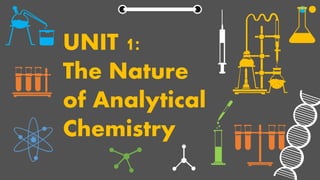
UNIT 1 - Introduction to Analytical Chemistry.pdf
- 1. UNIT 1: The Nature of Analytical Chemistry
- 2. Outline ✔ The Role of Analytical Chemistry ✔ Quantitative Analytical Methods ✔ A Typical Quantitative Analysis ✔ An Integral Role for Chemical Analysis: Feedback Control System
- 3. 1A: The Role Of Analytical Chemistry
- 4. What is Analytical Chemistry? 1A: The Role of Analytical Chemistry Task: Create a concept map about analytical chemistry as a discipline and its significant applications in households, industries, and other disciplines, etc. (10 mins.)
- 5. Analytical Chemistry It is a measurement science consisting of a set of powerful ideas and methods that are useful in all fields of science, engineering, and medicine. 1A: The Role of Analytical Chemistry
- 6. 1A: The Role of Analytical Chemistry
- 7. 1A: The Role of Analytical Chemistry
- 8. 2 Types of Chemical Analysis 1A: The Role of Analytical Chemistry Qualitative Analysis – reveals the identity of the elements and compounds in a sample. Quantitative Analysis – indicates the amount of each substance in a sample.
- 9. 1A: The Role of Analytical Chemistry
- 10. 1A: The Role of Analytical Chemistry
- 12. 1B: Quantitative Analytical Methods Challenge: Devise ways on how you can determine the mass of the barium present in a barium chloride solution of an unknown volume. (10 mins.)
- 13. Quantitative Analytical Methods 1B: Quantitative Analytical Methods Gravimetric Methods – determine the mass of the analyte or some compound chemically related to it.
- 14. Quantitative Analytical Methods 1B: Quantitative Analytical Methods Volumetric Method – measures the volume of a solution containing sufficient reagent to react completely with the analyte.
- 15. Quantitative Analytical Methods 1B: Quantitative Analytical Methods Electroanalytical Methods – measure electrical properties such as potential, current, resistance, and quantity of electrical charge.
- 16. Quantitative Analytical Methods 1B: Quantitative Analytical Methods Spectroscopic Methods – explore the interaction between EM radiation and analyte atoms or molecules or the emission of radiation by analytes.
- 18. 1C: A Typical Quantitative Analysis Recall: List down the steps in conducting a scientific method. Give at least one concrete example. (10 mins.)
- 19. 1C: A Typical Quantitative Analysis
- 20. Steps in Conducting a Quantitative Analysis 1C: A Typical Quantitative Analysis 1. Choose a Method Considerations: required accuracy level, number of samples, sample complexity/components Challenges: intuition-based, large investment time/money
- 21. Steps in Conducting a Quantitative Analysis 1C: A Typical Quantitative Analysis 2. Acquire Sample (rep. sample) Considerations: large/bulk and heterogenous - > great effort is required to get the representative sample Solution: Sampling (process of collecting a small mass of a material whose composition accurately represents the bulk of the material being sampled); Assay (process of determining how much of a given sample is the material by its indicated name)
- 22. Steps in Conducting a Quantitative Analysis 1C: A Typical Quantitative Analysis 3. Processing the Sample 3.1 Preparing a Lab Sample - solid samples must be ground to decrease size and ensure homogeneity and stored for various lengths of time before analysis begins. - dry sample before the start of analysis - If liquid/gas samples, keep in sealed containers to prevent contamination
- 23. Steps in Conducting a Quantitative Analysis 1C: A Typical Quantitative Analysis 3. Processing the Sample 3.2 Defining Replicate Samples - Replication improves the quality of the results and provides a measure of their reliability.
- 24. Steps in Conducting a Quantitative Analysis 1C: A Typical Quantitative Analysis 3. Processing the Sample 3.3 Preparing Solutions: Physical & Chemical Changes - Dissolution
- 25. Steps in Conducting a Quantitative Analysis 1C: A Typical Quantitative Analysis 4. Eliminating Interferences - Species other than the analyte that affect the final measurement are called interferences, or interferents. Matrix/sample matrix – is the collection of all the components in the sample containing an analyte.
- 26. Steps in Conducting a Quantitative Analysis 1C: A Typical Quantitative Analysis 4. Eliminating Interferences - Techniques or reactions that work for only one analyte are said to be specific. Techniques or reactions that apply to only a few analytes are selective.
- 27. Steps in Conducting a Quantitative Analysis 1C: A Typical Quantitative Analysis 5. Calibrating and Measuring Concentration - All analytical results depend on the final measurement X of a physical or chemical property of the analyte. - The measurement of the property X is directly proportional to the concentration 𝑐𝐴: 𝒄𝑨 = 𝒌𝑿 where 𝑘 is a proportionality constant
- 28. Steps in Conducting a Quantitative Analysis 1C: A Typical Quantitative Analysis 6. Calculating Results - Computing analyte concentrations from experimental data is usually relatively easy, particularly with computers. - Computations are based on raw experimental data collected in the measurement step, characteristics of the measurement instruments, and the stoichiometry of the analytical reaction.
- 29. Steps in Conducting a Quantitative Analysis 1C: A Typical Quantitative Analysis 7. Evaluating Results by Estimating Reliability - Analytical results are complete only when their reliability has been estimated.
- 30. 1D: An Integral Role for Chemical Analysis: Feedback Control Systems
- 31. An Integral Role for Chemical Analysis 1D: An Integral Role for Chemical Analysis: Feedback Control Systems
- 32. Feedback Control System – refers to the process of continuous measurement and control. Feedback Loop – refers to the cycle of measurement, comparison, and control. 1D: An Integral Role for Chemical Analysis: Feedback Control Systems An Integral Role for Chemical Analysis
- 33. Reference Skoog, D.A., West, D.M., Holler, F.J., Crouch, S.R. (2021). Fundamentals of Analytical Chemistry (10th ed.). Cengage Learning.